|
With the explosion in
domain values in recent years Grant has been well rewarded for
his prescience. So much so that he has begun giving back through
a series of generous domain donations (totaling hundreds of
thousands of dollars) to grateful educational institutions in
the U.S., including his alma mater, Arizona’s Prescott
College.
There
were times in Grant’s life when the kind of philanthropy he
practices today would have seemed like the wildest kind of pipe
dream. He had walked away from a good job on Madison Avenue
so he could move to New York’s Adirondack Mountains,
even though there was no job waiting for him there. After the
move, the company he started wound up folding but like all great
entrepreneurs, Grant bounced back and bounced back big.
Some of
that resiliency may have come from growing up with two
rambunctious brothers. The three boys were born in a five year
span starting in 1953 when Rob was the first to arrive. The
family lived in Evanston, Illinois (suburban Chicago)
at the time but soon moved to Memphis then on to Providence,
Rhode Island as Rob’s dad climbed the corporate ladder,
becoming a VP at one of the first business conglomerates, Textron.
|

Rhode
Island's Narragansett Bay |
Most of
Grant’s formative years were spent living near Rhode
Island’s Narragansett Bay where he developed a
love of sailing (a love that played a big role in his
first successful business that we will be talking about
shortly). He would sometimes take off for days at a
time, exploring the Atlantic Coast in a 25-foot sloop.
Grant also developed an appreciation of nature and love
of the outdoors during this time and that love would be
a critical factor in the decision I mentioned earlier to
walk away from a promising advertising career in New
York City. |
Though
he had an idyllic life in New England, Grant said he had
grown a bit tired of “East Coast culture” finding it a
little to pretentious for his tastes. “I rally wanted a change
and I had never been out west so it had this romantic appeal to
me. Prescott was also an experimental college that offered a
brand new concept allowing students to design their own courses
and majors. It was something that really clicked with me – a
chance to get out in the great wide open west and explore the
world in this unstructured academic environment,” Grant said.
| “Prescott
also attracted a lot of rebellious, independent thinkers
and it was a very exciting mix. We all knew we were part
of something knew and I just found it
to be exhilarating,” Grant added. |
|
That
freedom to be as creative as he wanted to be would serve
Grant well when he graduated and went out on his own.
Grant
headed backed to Rhode Island and opened his own
business – in fact two of them. One was a boat
building company called Breton that manufactured
16-foot daysailers. The other was a restaurant in
historic Newport, a joint venture with some
friends. Breton leased and managed fleets of sailboats
for local resorts that would in turn make them available
for guests to rent. |

Classrooms
at Prescott College |
|
While in
that business and interesting twist of fate would send Grant off
in an entirely new direction. In 1977 the America’s Cup
yacht race would be coming to Newport and Grant knew the whole
world would be watching – especially since the Cup would
be defended by the Mouth of the South, media mogul Ted Turner
(who would wind up winning as the skipper of Courageous).
Grant got the idea to use the sails on his fleet of boats as
huge billboards that would be impossible to miss when the TV
cameras from around the world were trained on the yachts racing
through local waters.
“The
concept was something that no one else had tried at the time,”
Grant said. “I pitched the idea and was able land King
William Scotch as our sponsor." Grant hired a handful
of craftsmen to hand sew the giant highly detailed logos on the
sails of more than a dozen boats.” The whole idea was kept as
quiet as possible because Grant new if they stodgy America’s
Cup committee got wind of it, they would be horrified and do
anything they could to keep Grant’s boats out of camera range.
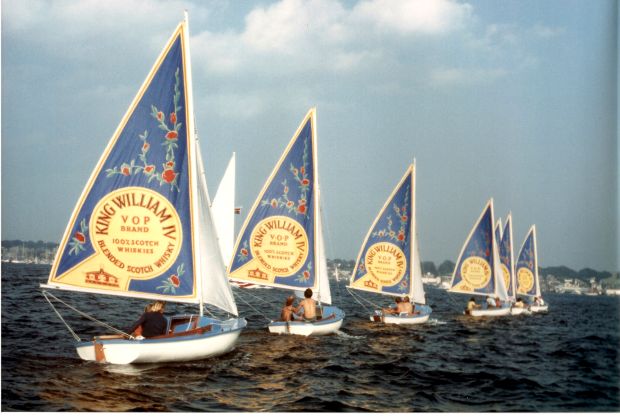
Rob
Grant's King William Scotch flotilla at the 1977 America's Cup -
Newport, RI
“The
day of the race we towed the boats out to the entrance of
Newport Harbor. Moments later hundreds of press boats from
around the world headed our way and up went our King William
Scotch sails! It was beautiful day and the sails were just
beautiful as we cruised in formation right through the press
fleet. You could literally hear the motor drives on their
cameras whirring away because they had never seen anything like
this at the America’s Cup before,” Grant recalled fondly.
“Instantaneously we wound up in about 150 publications
worldwide including Newsweek who ran a big story on this.”
The
scotch company was understandably delighted with the worldwide
exposure they got for around $40,000 and that successful
gambit opened the door for Grant to start an entirely new
company called Creative Sail. “You never know where
something is going to lead,” Grant said. “You start with one
idea and it morphs very quickly into another. The whole point of
this is that you have to remain very opportunistic and very
unstructured in your thinking. I think that is the hallmark of
anyone who is successful - they are very good at turning on a
dime necessary and that is what I have tried to do throughout my
career.”
|
In
fact soon after this success with sailboat advertising,
Grant decided to turn on a dime again and head for New
York City to see if he could parlay his marketing skills
into a career on Madison Avenue. He set up shop in what
he called an incredibly seedy hotel on the West Side
where he hooked up with aspiring art directors that
helped him a produce a portfolio of storyboards to take
around to the different agencies to see if one would
like what they saw and give him a chance.
“It
was a very grueling process but finally someone at Grey
Advertising sent my portfolio up to their new
Creative Director |
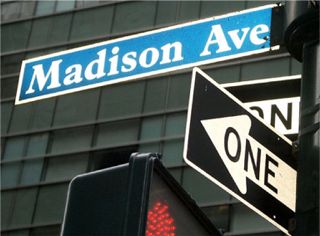
|
| Billy
Giles (a major figure on Madison Avenue at the time)
who thought Grant had real potential. He called Rob into
his office and after a short interview asked him is he
could start the next day. “I was stunned. I had been
looking for so long I didn’t really expect to hear
anyone say yes,” Grant said. But Giles did and Rob’s
foot was in the door. |
Even
though he started out with a desk in the hallway with the
secretaries, Grant was ecstatic just to be there, especially
since Grey was one of the world’s top ad agencies. His first
big break came when he was in on one of several creative teams
that were given an assignment to come up with a slogan for the
Playtex company describing a new bra that broke new ground
in terms of comfort for the women who wore them.
Grant,
intent on making a name for himself, stayed up until the wee
hours almost every night trying to come up with something. Grey
told the writers to concentrate on the word “fit” (just as
domainers would concentrate on keywords when they came on the
scene years some 15 years after this). Among the words and
phrases Grant scribbled was TGIF only his translation for
the famous acronym was “Thank Goodness it Fits”. “I
looked at it and said That’s It! I knew it was going to
be huge,” Grant said. When he showed it to the Creative
Director the next morning a big smile crossed his bosses’
face. Playtex loved it to and Grant’s idea appeared in all of
their ads. The campaign was very successful and Grant was soon
ushered into his own office as a reward.
|
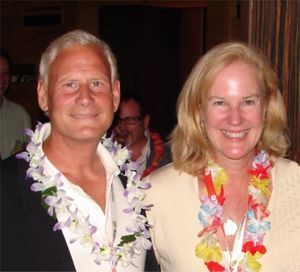
Rob
& Pat Grant
New York City - June 2007 |
He was
soon working on other major accounts including
Proctor & Gamble, Northwest Orient
and STP (which resulted in him working directly
with legendary NASCAR driver Richard Petty
who was the company’s spokesman). In addition to his
status as a highly respected copywriter, Grey brought
Grant something even better. He met a lovely young
account executive there named Pat and they soon
fell in love and were married. However Grant found there
was also a downside to what he was doing. Advertisers
doled out multi-million dollar accounts based on how
well the liked the ideas coming our of the different
agencies. Landing one big account could make or break a
company. “It was a very intense period. I
literally worked day and night,” Grant recalled. |
After
six years in a very high pressure job burn out started to
set in just as Rob and Pat had their first child, Elizabeth
(Caroline and Charlie followed over the next few
years to round out the family). With a family to think about
now, they decided to pull up stakes and make a radical change in
their lifestyle by moving upstate to the mountains. All of their
friends thought they were crazy and warned they that if they
walked away from their jobs they would never be able to come
back. Grant said, “even so I looked at my life and thought is
I stayed in Manhattan and raised a family it would be enormously
expensive and we would have to live in an apartment out in the
suburbs. It just turned me stomach to think that I could spend
the rest of my life going back and forth to the city on a
commuter train.”
“I
also thought here I am, expending all of this creative energy to
make money for other companies – why can’t I do this for
myself? I had this tremendous urge to channel all of this energy
into something that would be mine. So we made the move and
headed for the Adirondacks. We rented a house up there but
didn’t have a clue what we were going to do! It was a very
scary time,” Grant said.
| He
finally decided to start an Adirondack furniture company
in Saranac Lake (Adirondack furniture is a
popular style of casual outdoor camp furniture that
originated in that region). “The idea was to take
something that had always been a cottage industry and
market it on a national scale,” Grant said. The
furniture company started hiring local craftsman and
their high quality hand made pieces were soon in high
demand. In fact a big Christmas order from Saks Fifth
Avenue led to Grant personally loading a U-Haul
trailer to take a load of his furniture back to
New York City where the pieces were displayed in Saks’
windows. |

Adirondack
chairs |
Grant
targeted the design trade and gained strong acceptance in the
high end market. The problem was they couldn’t find enough
qualified reliable craftsman to produce enough pieces to meet
the demand. Eventually he came to grips with the fact that this
was a cottage industry that wasn’t scaleable and decided it
was once again time to try something new.
Grant
had actually already taken the first steps on another path while
the furniture company was still going. “I was beginning to buy
real estate because I felt there was a great opportunity in
these mountain resorts where I thought property was grossly
undervalued. I began to buy old commercial buildings in Saranac
Lake and residential property in Lake Placid. I remember
buying an old 3-story commercial building for $20,000! I
got seriously involved in rehabbing these buildings and then
turning around and selling them.”
“We
happened to get lucky because we hit that market just as the
Adirondacks were starting to be rediscovered,” Grant said.
“People were starting to come up from New York, New Jersey and
Boston and I found I was able to sell the residential properties
especially for two and three times what I paid for them.
That kind of ushered in my real estate era.”
|

Camp
Cobblestone
One of the multi-million dollar waterfront
camps
Grant & Associates has listed over the years. |
Real
estate was an area is which Grant really thrived.
“Around 1991 I decided to start a brokerage firm,”
he said. “but in 1991 we wound up entering one of the
worst recessions in history, one that went on for two or
three years. I remember thinking my time could not have
been worse.” Still Grant managed to hang on and
slowly built a reputation during those lean years,
especially when he won listings for local waterfront
camps (properties that could sell for $1-$5 million).
His marketing background came in handy because it
allowed him to develop marketing plans for property
owners that other brokers couldn’t do as well. That
was the birth of today’s powerful Rob
Grant & Associate Real Estate firm. |
As the
economy started growing again, Grant’s business boomed. At
this same time, in 1995-96, Grant became aware of the Internet
and domains. “That was a remarkable awakening for me because I
had the Madison Avenue marketing background and I had the real
estate background and suddenly these two powerful thing merged.
I looked at a domain and thought My God, not only is this a
brand as the Internet develops, but it is also has all of the
properties of real estate,” Grant said.
A web
designer working on a site for him told Grant he should register
his RobGrantRealEstate.com but (though he did take that
domain) he had bigger ideas from the start. “Nobody here cared
about Rob Grant – what they cared about was Adirondacks Real
Estate and I felt that is what they would look for.” When he
looked to see who had AdirondacksRealEstate.com
he was surprised that it was available for registration. He
quickly took it then, convinced he was in to something big, went
on to take thousands of other .com domains starting with a city,
state or country name and ending with “real estate.”
At that
time Network Solutions had a monopoly on domain
registrations so it cost about 10 times what it costs to
register a domain today. So, Grant laid out a huge amount of
capital on a theory that most thought would never pan out. Also
keep in mind that back then there was no PPC, no Yahoo
and no Google, so the domains had only one apparent value
– their generic brand value. Grant said, “my hunch was that
as the Internet grew and developed these intuitive brands would
take on more value as property and assets.” That was the
beginning of Grant’s remarkably deep Real Estate Directory at RealEstateDirectory.com.
|
Grant
soon started taking his idea global, sweeping up major
city real estate domains outside the U.S. “That was
really an exciting time because no one had thought to go
international,” he said. “There was very little
resistance, unlike today when there is so much
competition.” Though Grant was focused on real estate
he realized that this same phenomenon would happy in
many other industries. “If you could own a keyword
term for a particular industry that was a very
significant asset so picked up some in other categories
too, like TropicalFish.com, CaribbeanResoirts.com,
LiteraryAgents.com, BookPublishers.com and
MusicPublishers.com”
On
the downside, the more domains Grant piled up the
scarier it got because of the extremely high annual
registration and renewal fees at that time. “It was
brutal,” Grant said, “because you had these high
carrying costs but absolutely no revenue. You really had
to believe. I feel it was the true test of whether or
not someone has vision. I sat for years paying these
registration fees and not earning a nickel and wondering
if I was out of my mind.” Grant, who piled up
over 5,000 domains (many are featured at WebMediaProperties.com),
added something that a lot of guys (including me) can
also identify with, “my wife also wondered if I was
out of my mind!” |
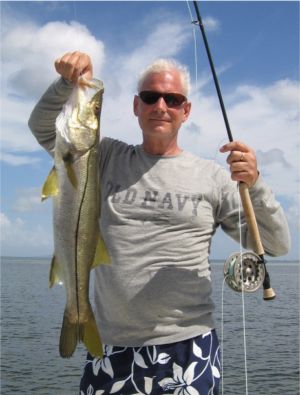
Grant
hooks a big one.
Photo shot earlier this month (April 2008)
off Anna Maria Island, Florida where
Grant has a vacation condominium |
Grant not
only held on when the .com bubble burst in 2000 (reinforcing
critic’s views that domain investors were nuts) he used that
as an opportunity to buy yp more high quality assets as others
panicked and sold out cheap. “They had decided they had made a
bad move, that they had been in it long enough and they had made
a bad investment and they were getting out. I remember buying
good domains for a dime on the dollar,” Grant recalled.
“I
can’t tell you how many times people told me to get out. That
the domain thing was over – especially the techie guys. They
never got it. They didn’t have the marketing background and I
know they kick themselves to this day for not understanding the
true value of these names,” Grant said. “I’ve seen so many
peaks and valleys since 1996 and in each valley there was a
washout as people get scared or got discouraged and got out.
Then a new generation would come in with a new sense of
conviction.”
Grant’s
belief in real estate domains has never wavered and today there
are now multiple ways to monetize those domains He has some
leased out through LeaseThis.com
and there is always PPC, but for the best returns can be
realized through lead generation. For example he has HawaiiRealEstate.com,
representing a state where the average home sale is $750,000.
A single lead to a licensed broker in Hawaii can be worth up to
$45,000.
Grant
did better than that with a listing on his CatskillsRealEstate.com
site several years back. Though his company was several hours
north of the Catskills, he won a list for a very large
multi-million dollar estate and marketed it through his
Catskills domain. He ended up selling the property in house with
no help from any Hudson Valley or Catskills area
realtors, giving him the full commission – approximately $150,000.
“These showed me that with the Internet you could each out
beyond your traditional territory – you were no longer
restricted by conventional boundaries which might extend maybe
50-70 miles from your agency was,” Grant said. “It was a
great case study for me.”
With his
business thriving, Grant started looking for ways to give back
to a cause he believed in and a few years ago he settled on
higher education, especially small schools like his Prescott
College alma mater. Again drawing on his marketing background
and the power of domains he felt he could help quality schools
that were struggling compete more effectively with better
endowed institutions chasing the same pool of students.
|
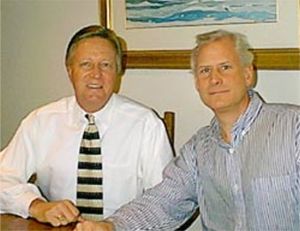
Paul
Smith College President
George Miller (left) with Rob Grant |
“By
giving them intuitive domains we felt we could help them
increase their admissions and also increase their brand
exposure, “ Grant said. “We started with Paul
Smith’s College in our neck of the woods in the
Adirondacks. They had a very enlightened president who
was receptive to the idea so we were able to work with
them to build a network of domains that effectively
drove traffic to the college’s website. All they
needed was one applicant enrolling from the program fo
four years to gain $120,000 in tuition. We
started by giving them $10,000-$15,000 worth of
domains and they were very excited with the results so
went on and gave increasingly larger gifts to other
colleges.”
The donated
domains are appraised by Moniker.com and though
many appraisal |
| companies
tend to come in on the high side (to ensure happy
customers who will come back and order more appraisals)
the long list of appraisals I saw for names Grants
donated were on the very conservative side. This is
probably why Moniker’s domains appraisals are
recognized and accepted by the IRS. |
Grant
made a portfolio gift valued at $60,000 to Prescott
College that included Conservationism.com, FinancialGrant.com,
LiberalArtsDegrees.com, MastersDegreePrograms.com
and many others. He followed that up with another portfolio of
107 domains valued at over $99,000. A portfolio valued at
over $237,000 went to his daughter Caroline’s present
school, St. Lawrence University in Canton, New York.
In 2006, a portfolio of 225 domains valued at more than $371,000
was given to the College of St. Scholastica in Duluth,
Minnesota. Paul Smith’s College also got new gifts
totaling over $84,000.
The
schools have been thrilled with the donations. Grant has also
consulted closely with school officials on how to best use the
domains. While there is a lot of valued in redirecting keyword
domains to the the individuals school’s websites, some are
moving beyond that. St. Scholastica is setting up a committee to
work on building out some of the marquee domains given to them.
Both faculty and students will be involved in those projects.
Grant is
now expanding his program beyond colleges to other community
organizations and non-profit groups. He also provides hosting
services and website marketing advice to many groups in his
area. More details are available at Grant’s Adirondacks.com
website.
Adirondacks.com
is one of about 1,500 developed websites that Grant operates. It
includes it a busy travel section and Grant is now applying the
same formula to travel guides in Florida and Vermont.
Though domain development has just become a front burner issue
over the past year as PPC revenues have fallen Grant has been
developing properties for ten years now. “It takes a lot of
hard work, you’ve got to have the right content, you have to
continually refresh that content and you have to have a sales
team that goes out and gets the advertisers.”
Development
is just one of many ways Grant has financially diversified in
recent years to protect himself from shocks in any one category.
“In addition to our real estate brokerage, we operate a self
storage business, we have a big vacation rental business, I
operate a 23,000 square foot office building, so we have both
commercial tenants and residential tenants. One of the lessons I
learned early on was that it is very important to be as
diversified as you can be. You can’t rely on any one business
model because if you do you will be taken out. I’ve
seen it time and time again and I’ve had it happen to me. So
anytime I see an opportunity to create a business, or even just
another revenue stream, I do it.”
Grant
has been around long enough to see just about every conceivable
up and down in the business cycle. With the general economy now
going through a major down cycle, I asked him what he thought
about the domain industry’s prospects over the next year or
two. “I think we’re going to go through a very intense
period and I think we are going to go through another shakeout.
We have seen these rough patches historically in the domain
space and I think right now we are faced with multiple threats.
There is going to be more and more dangerous legislation created
that could take our domains away and I commend the Internet
Commerce Association for everything they are doing
to combat that and everyone needs to understand how important it
is to support the ICA” Grant said.
Grant
added, “The National Association of Realtors (NAR)
understood decades ago how important it was to have an
organization that could lobby on Capitol Hill and the NAR is one
of the most powerful lobbying groups in the world. What we have
seen in the real estate industry is wave after wave of
potentially damaging legislation and it has always been the NAR
and their lobbyists who have protected this industry. They can
do it because they are so well funded and so well organized and
because the individual members all understand the importance of
having that kind of representation. The domain industry, as
young and as small as it is, needs to very quickly understand
that if they don’t have this same kind of representation, they
will not last. They will not be an industry, they will be
a footnote in the history of the Internet.”
Despite
the hurdles ahead Grant remains bullish about the long run,
predicting that current monetization methods will be
supplemented by new models. “I think we are going to see pay
per call, pay per action, much more sophisticated lead gen.
Ultimately the best domains will rise to the top and those will
be the big powerful generic domains. Many of those will move
from being a $200,000-$1 million asset to being a full
blown company that’s worth $30 million-$50 million and
I think that’s where we’re going to go next.”
“I
think a lot of today’s PPC companies will morph into
development partners because they already have the client base
and they’ve already established the loyalties so I think
you’re going to see these companies approach portfolio owners
with development proposals. The owners will merge their domains
with the technology and the expertise of these parking companies,"
Grant said. Sound unlikely to you? Visionaries don't always have
20/20 vision, but with Grant's track record I wouldn't discount
anything he has to say about the future.
|


























